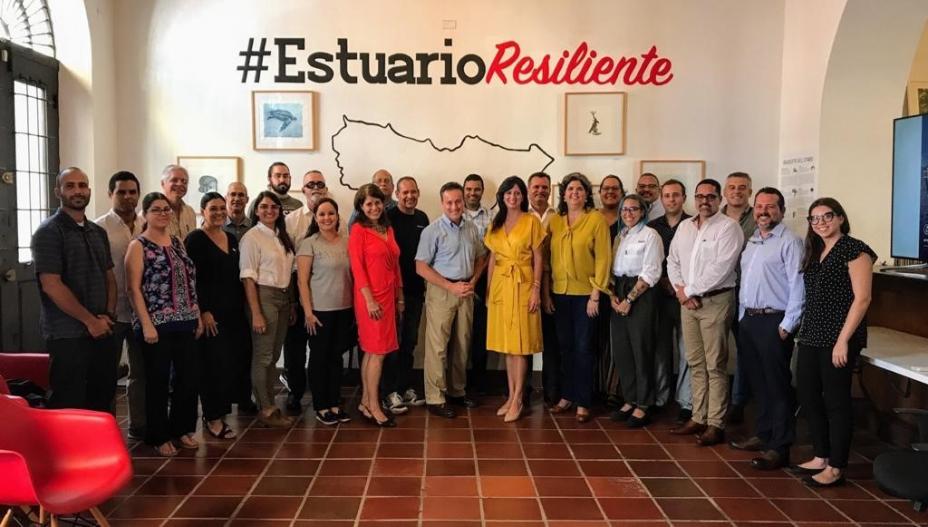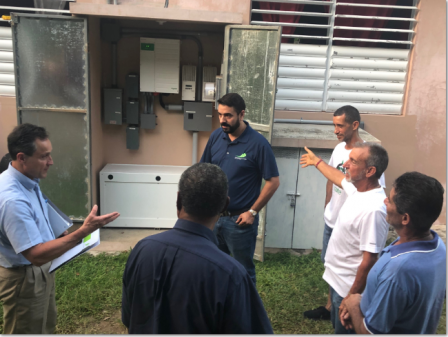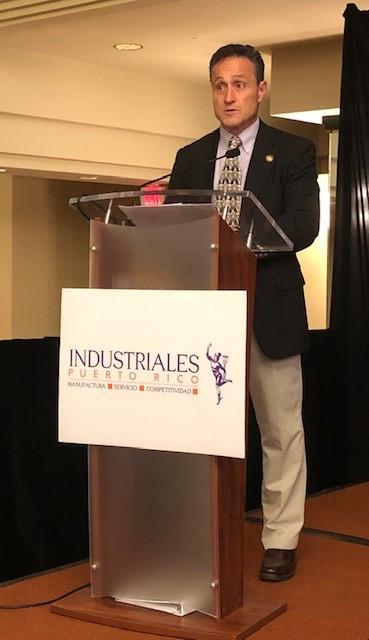News Releases from Region 02
EPA Regional Administrator Wraps Up Successful Visit to Puerto Rico
As Recovery Efforts Continue in Puerto Rico, EPA Focused on Capacity Building and Infrastructure Investments
SAN JUAN, PUERTO RICO – Recently, U.S. Environmental Protection Agency (EPA) Regional Administrator Pete Lopez visited Puerto Rico as part of EPA’s aggressive efforts to advance recovery from Hurricanes Irma and Maria, as well as tackle ongoing environmental challenges in the Caribbean. The trip included participation in important forums, with a diverse array of community groups such as the San Juan Bay Estuary program, the Coral Reef Task Force and the Puerto Rico Manufacturers Association. Regional Administrator Lopez also met with commonwealth and local partners to strengthen the partnerships formed during the emergency response and continue the close coordination on recovery efforts, including solid waste management, upgrading drinking water systems and addressing wastewater infrastructure issues.
“Puerto Rico is on the path to recovery from the 2017 hurricanes, but the journey will be a long one. EPA is committed to taking that journey with the dedicated community leaders and officials who are essential to a successful recovery,” said EPA Regional Administrator Pete Lopez. “We continue long-term recovery work with the overarching goal of helping Puerto Rico and U.S. Virgin Islands communities build capacity and regain their footing. We are actively working on a multitude of issues, including solid waste, drinking water in small rural communities, stormwater management and resiliency, septic tank replacement, brownfields and workforce development as well as coral reef preservation and protection.”

EPA Regional Administrator Pete Lopez in San Juan, Puerto Rico, with participants at the San Juan Bay Estuary Program meeting (Background sign reads: Resilient Estuary).
EPA leads water sector investments and improvements
The agency launched an initiative to help make septic systems more sustainable and resilient. Regional Administrator Lopez visited communities and local leaders to discuss improvements, including a new septic system pilot project that evaluated septic tank shortfalls and developed cleanup plans in communities to protect the San Juan Bay Estuary.
"After Maria, coastal communities in the San Juan Metro region were flooded for days and even weeks, jeopardizing public and aquatic ecosystem health of the estuary. Of particular concern were the functioning of septic systems in these regions, which prompted Estuario to undertake a septic tank evaluation and cleanup project in two underserved communities of Cataño,” said San Juan Bay Estuary Program Executive Director Brenda Torres Barreto. “The project aimed at providing a service that was desperately needed, and at helping other project managers visualize the complexities behind these projects by carefully documenting every step of the process. The project was successfully completed, and we are now in the process of exploring solutions that are aligned with the communities' interests and demonstrated needs."
Septic systems are used to treat and dispose of relatively small volumes of wastewater, usually from houses and businesses located in suburban and rural locations not served by centralized public sewer systems. In May, the EPA hosted the second Caribbean Septic System Working Group meeting to share to federal, state and local stakeholders a proposed action plan for the recovery of septic systems in Puerto Rico and a pilot project cleanup initiative for faulty septic systems in Cataño that affect the San Juan Bay Estuary. When Cataño communities flood, overflow discharges from ill-built or damaged septic tanks reach waterways impacting the health of the San Juan Bay and its residents. The septic tank cleanup initiative in Cataño communities involved assessment, outreach, inspection, cleanup, water quality monitoring and feedback collection. The results of the project determined that all the septic tanks evaluated need some type of improvements, repair and/or complete elimination. EPA intends to build on this partnership with the Estuary Program, the commonwealth, and communities like Cataño to develop strategies and make investments that ensure these systems run safely and sustainably to protect public health and the environment.
EPA to provide support to Toro Negro, Ciales, community aqueduct and renewable energy
As part of his visit, Regional Administrator Lopez attended a collaborative meeting between EPA Region 2 staff and the Puerto Rico Community Foundation to learn about the support being provided in the establishment of a community aqueduct as well as a renewable energy system for a rural community in Toro Negro, Ciales, to provide water and electricity to 14 houses in the community. The future support provided would include a resilient system for the community that meets regulatory requirements.

EPA Regional Administrator Pete Lopez in Ciales, Puerto Rico, discusses renewable energy while viewing a microgrid project made possible by the Puerto Rico Foundation and SOMOS Solar.
In Toro Negro, Ciales, after suffering eight months without power, residents built solar microgrids and utilized batteries with the help of the Puerto Rico Community Foundation and SOMOS Solar, achieving its energy independence. It is the first solar community microgrid project in the history of Puerto Rico registered and certified at the Puerto Rico Energy Bureau. By generating its energy from 100% solar power, the project also has a positive footprint in the environment. The Toro Negro projects is an example of how non-governmental organizations can collaborate to strengthen communities by making them more resilient against future natural disasters, while achieving energy independence.
EPA continues manufacturing sector and coral reef protection partnerships
A visit with the Puerto Rico Environmental Committee of the Puerto Rico Manufacturers’ Association by Mr. Lopez highlighted the U.S. EPA’s 2019 Agenda of Regulatory and Deregulatory Actions and how companies can inspire others in the manufacturing sector to invest in innovative technologies and business practices that save fuel, cut waste, protect the environment and create jobs. EPA values the importance of partnerships at all levels to promote local sustainability and ensure measurable, positive environmental outcomes.

EPA Regional Administrator Pete Lopez in San Juan, Puerto Rico, at meeting of the Puerto Rico Manufacturers’ Association.
Mr. Lopez also gave welcoming remarks at the Caribbean Coral Reef Partnership Meeting, which is a partnership of 14 federal and local agencies to facilitate communication on threats to coral reef ecosystems. EPA Region 2 co-led the event, focusing on effective coral reef protection and conservation Puerto Rico and the U.S. Virgin Islands, improving cross-program and agency coordination, and coordinating on disaster response and recovery efforts.
EPA Region 2 hurricane response and recovery background
In September 2017, EPA responded, in partnership with the Puerto Rico and U.S. Virgin Islands governments and partner federal agencies, to the devastation that Hurricanes Irma and Maria left in their wakes. EPA deployed a total of more than 700 personnel in its response.
EPA’s emergency response to the hurricanes included a broad array of interventions such as collecting hazardous materials and hazardous waste, assessing wastewater treatment plants and pumping stations; assessing more than 200 rural, “non-PRASA” (Non-Puerto Rico Aqueduct and Sewer Authority) drinking water systems in Puerto Rico; assessing Superfund sites and chemical, waste and oil facilities; rebuilding Puerto Rico Environmental Quality Board’s scientific laboratory; and helping repair air monitoring networks in both Puerto Rico and the U.S. Virgin Islands. The agency continues this work and more as part of its dedicated, long-term recovery efforts.
On June 4, 2019, EPA and the Federal Emergency Management Agency (FEMA) announced a Memorandum of Understanding (MOU) that streamlines coordination between FEMA and the EPA-funded State Revolving Fund (SRF) programs so that funding to restore vital water infrastructure can be provided as quickly as possible in times of disaster. In disaster situations where cash reserves are stretched thin, the EPA-FEMA MOU provides a tribe or local government access to a no-interest or low-interest loan from its SRF to help pay for the immediate restoration of vital drinking water and wastewater infrastructure.
“We are dedicated to improving public health and the environment for our more than 3 million neighbors in the commonwealth,” concluded Regional Administrator Lopez. “We know there is a lot of work ahead of us but have faith in the strong partnerships we enjoy with our federal, state, and local groups and leaders. Together, we have the energy, passion and ability to get the job done.”
Follow EPA Region 2 on Twitter at http://twitter.com/eparegion2 and visit our Facebook page,
http://facebook.com/eparegion2.
19-058
